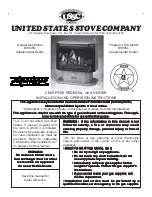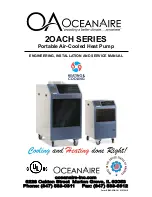
21
3. HORIZONTAL REMOTE MOUNTED RADIATORS
When cooling with a horizontal remote radiator, the system should be piped as shown in
Figure 8. A separate surge tank is required and must be the highest point in the
system. A 3/4 inch to 1 inch (*) fill line is required from the bottom of the surge tank to
the outlet tank of the radiator or the pump suction piping to prevent pump cavitation. A
1/4 inch to 1/2 inch (*) vent line is required to the surge tank from the radiator inlet
tank. If the engine is higher than the radiator or if the engine requires it, a 1/4 inch to
1/2 inch (*) vent line is required to the surge tank or highest point in the system from
the thermostat housing. The customer should install a drain valve at the lowest point in
the system.
4. DUAL-LOOP SYSTEMS
When a shell and tube or plate and frame heat exchanger is used with a horizontal
remote mounted radiator, two surge tanks are required and both should be the highest
points in their respective circuits (See Fig. 9). A 3/4 inch to 1 inch (*) fill line should be
installed from the bottom of the radiator surge tank to the radiator outlet tank. A 3/4
inch to 1 inch (*) fill line should be installed from the bottom of the engine surge tank to
the pump suction piping. A 1/4 inch to 1/2 inch (*) vent line should be installed from the
radiator inlet tank to the radiator surge tank and from the engine thermostat housing to
the engine surge tank.
5. TWO-CIRCUIT RADIATORS
When a vertical remote radiator is used as a two-circuit radiator, it should be piped as
shown in Figure 10. When low flow in the aftercooler circuit requires a two-pass
arrangement, both the inlet and outlet will be in the bottom tank. The radiator top tank
must be the highest point in the system. A 1/4 inch to 1/2 inch (*) vent line may be
required from the engine thermostat housing to the jacket water side of the top tank.
An aftercooler circuit vent line may also be needed if the engine requires it.
When a horizontal remote radiator is used as a two-circuit radiator, it should be piped as
in Figure 11. A surge tank is required for both circuits and both are piped to their
respective outlet tanks. The surge tanks must be the highest points in each circuit. A 1/4
inch to 1/2 inch (*) vent line from the inlet tank to the surge tank is recommended for
each circuit. A 1/4 inch to 1/2 inch (*) vent line from the thermostat housing to the
jacket water surge tank is required when the engine is higher than the radiator or if the
engine requires it. An aftercooler circuit vent line may also be needed if the engine
requires it. The customer should install a drain valve at the lowest point in each circuit.
6. ALL REMOTE MOUNTED RADIATORS
Flexible connections are required at all of the radiator connections. Strainers are
recommended. An auxiliary booster pump may be required depending on the
installation, such as distance from the engine, length of pipe, radiator elevation, quantity
and type of fittings, etc. All piping, vent and fill lines, strainers, drains, valves, and
gauges are customer supplied.
(*) Size of vent lines or filling lines is dependent on engine size and the
engine manufacturer’s recommendations.
















































